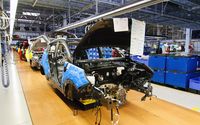Kia's Green Factories And Greener Life Cycles
LONDON – Nov 22, 2011: There is a groundswell of opinion which says that fuel consumption and emissions should not be the only factors taken into account when deciding if a car is ‘green’. The energy needed to make it, and the number of parts which can be recycled at the end of its life, should also be considered.
It is a point of view that Kia wholeheartedly agrees with ¬– because the company has been doing it for years. From the start of the design phase, all new Kia models are subject to a Life Cycle Assessment (LCA) to minimise their impact on the environment. And Kia suppliers are encouraged to do the same with their production processes.
In 2008, Kia launched a socially responsible management initiative
designed to put the environment at the forefront of all its operations.
Among other things, the company set out to:
Kia has received both internal and external recognition for its efforts. Using an internal environmental performance indicator, which measures CO2 emissions and the amount of resources used against sales revenue, Kia made a 40.1% improvement between 2004 and 2010.
Kia’s plant in Zilina, Slovakia was certified in 2008 as an ‘environmentally-friendly’ facility, earning an ISO 14001 International Certificate of Environmental Management. The plant employs cutting-edge technology to ensure that production and waste-management have minimal impact on the environment.
It’s not only the plants that are receiving awards the all new Picanto, Rio, Optima and Sportage have all been awarded environmental certificates from TUV Nord. The low tailpipe emissions from all four cars and the advanced processes used in their production, have resulted in the models being certified according to the ISO 14040 Life Cycle Assessment (LCA)
Digital assessments during the design phase help to minimise the number of changes necessary down the line, reduce costs and resource consumption and calculate how a car will dismantle at the end of its life. One benefit of this process is the development of more efficient dismantling equipment.
Since 2005 Kia has been using a self-developed chemicals management system to minimise the use of toxic substances, and in 2010 it began to analysethe composition and weight of all materials used in the construction of a car to aid recycling. All newly-developed Kias now meet recyclability and reusability standards in Korea, Europe and China.
All Kia factories are clean and efficient. The amount of waste, greenhouse gases and environmental pollutants they produce is monitored so that improvements can be made, and the heat they create is recycled.
Waste taken to landfill sites in 2010 was less than 1% of the total generated, and the giant Sohari and Hwasung plants in Korea have sent absolutely no waste to landfill for the past two years. In 2010, nearly 94% of the waste created at the three main Korean plants was recycled.
Kia has also reduced the amount of water used in the building of each car by 27% in the past seven years, and has achieved a steady decline in the greenhouse gases resulting from production since 2005, and company standards on environmental and atmospheric pollutants are higher than those demanded by the Korean government.
Kia’s decision to build cars in the markets where they will be sold, whenever possible, reduces the energy required for distribution. Kia is also replacing old transporters with new ones that can carry 20% more, and re-routing cargo through ports closer to production facilities.
Looking further into the future, Kia is researching ways of increasing the amount of shredded material from scrapped cars for recycling from 85% to 95%. The company has also developed a manual on how to safely dispose of the high-voltage lithium-ion batteries from the hybrid and electric vehicles that will soon be used in volume production.



